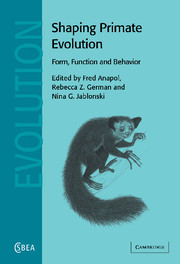Book contents
- Frontmatter
- Contents
- List of contributors
- Preface: shaping primate evolution
- 1 Charles Oxnard: an appreciation
- Part I Craniofacial form and variation
- Part II Organ structure, function, and behavior
- 6 Fiber architecture, muscle function, and behavior: gluteal and hamstring muscles of semiterrestrial and arboreal guenons
- 7 Comparative fiber-type composition and size in the antigravity muscles of primate limbs
- 8 On the nature of morphology: selected canonical variates analyses of the hominoid hindtarsus and their interpretation
- 9 Plant mechanics and primate dental adaptations: an overview
- 10 Convergent evolution in brain “shape” and locomotion in primates
- Part III In vivo organismal verification of functional models
- Part IV Theoretical models in evolutionary morphology
- Part V Primate diversity and evolution
- Index
- References
6 - Fiber architecture, muscle function, and behavior: gluteal and hamstring muscles of semiterrestrial and arboreal guenons
Published online by Cambridge University Press: 10 August 2009
- Frontmatter
- Contents
- List of contributors
- Preface: shaping primate evolution
- 1 Charles Oxnard: an appreciation
- Part I Craniofacial form and variation
- Part II Organ structure, function, and behavior
- 6 Fiber architecture, muscle function, and behavior: gluteal and hamstring muscles of semiterrestrial and arboreal guenons
- 7 Comparative fiber-type composition and size in the antigravity muscles of primate limbs
- 8 On the nature of morphology: selected canonical variates analyses of the hominoid hindtarsus and their interpretation
- 9 Plant mechanics and primate dental adaptations: an overview
- 10 Convergent evolution in brain “shape” and locomotion in primates
- Part III In vivo organismal verification of functional models
- Part IV Theoretical models in evolutionary morphology
- Part V Primate diversity and evolution
- Index
- References
Summary
Introduction
Charles Oxnard championed the use of statistical techniques to reduce a multitude of variables into a comprehendible pattern in order to demonstrate some aspect of primate behavior or evolution. In reality, Professor Oxnard's interests and writings have spanned an enormity and diversity of topics. By analogy, one might conclude that the “first principal component” of his work is reflected by the succinct statement on page 6 of his 1975 book, Uniqueness and Diversity in Human Evolution: “There is no doubt that the locomotor behavior of an animal is, on a gross level, controlled by the anatomy of the animal.” This point of departure for the research of many contributors to this volume, has influenced our own endeavor to understand how the internal morphology of a muscle itself, i.e., fiber architecture and histochemical fiber type composition, is associated with organ function and animal behavior. In this chapter, we consider the relationship of locomotor behavior, muscle function, and the fiber architecture of the gluteal and hamstring muscle groups.
Many classes of polymorphic variables determine the internal morphology of whole skeletal muscles. These include the relative composition of histo/immunocytochemical fiber types (see Chapter 7), neurological compartmentalization related to fascial partitioning (English, 1984) by the branching pattern of motoneurons (e.g., Herring et al., 1989, 1991), and the spatial arrangement of muscle fibers and tendons, otherwise known as fiber architecture (Gans and Bock, 1965; Gans, 1982; Richmond, 1998).
- Type
- Chapter
- Information
- Shaping Primate EvolutionForm, Function, and Behavior, pp. 99 - 133Publisher: Cambridge University PressPrint publication year: 2004
References
- 4
- Cited by

